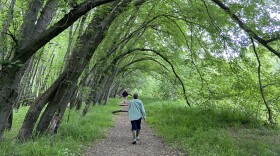As we celebrate 25 years of Something Wild, we hope you'll enjoy looking back at some of our favorite episodes. We're digging into the archives and reminiscing with producers. This episode was originally produced by Ross Boyd in April 2015. (Enjoy the bonus clips!)
For the past 20 years, peregrine falcons have shared the cliffs in Rumney with the rock-climbing community.
Chris Martin has been directing the monitoring of these birds since they arrived. In addition to tracking the progress of the falcons as they emerged from their endangered status, Martin and the Forest Service work closely with the climbing community to support recreation and maintain the safety of the falcons.

Martin recently took Something Wild co-host Dave Anderson and producer Ross Boyd (that's me) to visit the raptors. It was a tough first hike of the season — three inches of snow had fallen the night before, and Martin had to guide us along what he assured us were trails. But the payoff was spectacular.

Peregrines can't nest just anywhere, so the geography of New Hampshire dictates where these birds settle down.
The cliffs in Rumney are perfect for the falcons, who prefer ledges on vertical cliffs. There are about 44 peregrine falcons living in the state, and the pair in Rumney "own" all the cliffs in the area.
Peregrines are territorial, especially when it comes to other peregrines, so you won't find more than two at a given site. With that much space all to themselves, the falcons may choose to nest on any cliff they want.
For the safety of the climbers and the birds, the cliff housing that season's nest is always closed, requiring close monitoring around this time of year as Martin wants to be sure he's not closing an area needlessly.
On this trip, both peregrines were very active — a clear indication that there are no eggs yet.
When there are eggs in the nest, the falcons become very secretive. The female (the larger of the pair) will spend most of her time guarding the nest while the male gathers food.
We watched a food exchange between the falcons where the male flies around the nest announcing his arrival, the female flies out to meet him and takes the food - in midair! Martin explained this is pre-nesting behavior: The male retrieves food, usually a small bird, and offers it to the female. It's a courting phase where the male proves he will be a reliable mate.
As we approached the Summit cliff where the falcons have nested for the last several years, we saw interactions between the peregrines and ravens who also have a nest in the area. Most of the time they co-exist fine, but occasionally a line is crossed - as it was this day. Chris explained that peregrines eat small birds and will often cache their catches in crevices on the cliff and that the ravens, being scavengers, will try to raid those caches. We watched this scenario play out, then the peregrines announced their disapproval by aggressively swooping through the air until the ravens retreated.

Peregrine falcons have a reputation as the fastest animals in North America. Martin estimated that they can reach speeds of 150 to 200 mph.
These speeds are reached only in short bursts as they dive, but they average around 50 to 60 mph while flying in a straight line — still pretty fast! This is a falcon's primary weapon while hunting, they tuck in their wings and dive into a flock of birds (such as blue jays), stunning their prey, then swinging back around to collect their prize as it falls.
Being so close to peregrine falcons and seeing them in action was amazing, and I couldn't have asked for a better guide. You can learn more about the management and monitoring of peregrine falcons by visiting the NH Audubon page.











